
Back to Loco of the Month homepage
Back to Sidestreet Bannerworks
.
January 2005
Beck Anna
by Marc Horovitz

In 1979, there wasn't much going on in the world of small-scale live steam, especially in narrow gauge. Stewart Browne in England was producing 32mm gauge, 16mm scale locomotives under the name of Archangel. And, aside from Aster in Japan and a small number of custom builders, that was about it. The hobby as we know it today was in its infancy. LGB’s large, attractive, electric trains from Germany had been around a decade or so -- long enough to have been noticed by the market.
Chr. Beck & Söhne was an old German company making optical instruments in the city of Kassel. In 1979, the company introduced its first live-steam locomotive, Anna. Why it made the decision to branch out into steam engines is unknown, but in doing so, they followed a century-old tradition of optical-instrument makers who also produced steam engines. Anna, an 0-4-0T modeled after a series 99 Maffei locomotive, was available in the green you see here, and black. It was later followed by Helene, an 0-6-2 patterned after the Zillertal engines that LGB had made famous. In fact, both Anna and Helene were intended for use with LGB track and rolling stock. They were built to the same scale as LGB trains (1:22.5) and came equipped with LGB-style loop couplers. They did not, however, have insulated wheels, and so could not be operated simultaneously with electrically powered trains. A third engine, Bertha, was proposed, but never produced by Beck. This was to be a non-articulated 0-4-4-0T. A few of these were later produced by Tom Cooper (see below), but were not very successful. You can learn about one here. Beck also produced a couple of high-end models of very early German locomotives, in very limited numbers.
Beck's engines were little more than elaborate toys. They were more-or-less well proportioned, but had little in the way of detail. They were significant, however, in establishing what has almost become standard technology for gas-fired locomotives. Theirs were the very first, commercially produced, single flue, gas-fired boilers. They were heated with what is now known as the "poker" burner. Today, most companies producing gas-fired engines use the single flue, poker-burner technology pioneered by Beck.
In 1979, I went to England and Europe for the first time. There I discovered little steam engines, mostly through the evocative writings of D.G. Rowlands, who was quite active in the hobby at the time. Also, through magazine ads, I discovered the Beck Annas. Upon returning to the States, I decided to set up a small locomotive-import business. I wrote to Back and asked them to make me the exclusive US importer of their products. Astonishingly, they agreed! Sales were slow, as I had not the financial wherewithal to mount a large advertising campaign. Also, the hobby here was embryonic and, even with a lot of advertising, sales would have been slim. However, it was a beginning.
After a year or so, Beck became understandingly disappointed with my performance, and so took the dealership away, giving it to a company called Small World Toys, who immediately placed an order for 100 units (I think I had sold about six). This lasted another year or so, and they called it quits. I ended up buying the last ten of their remaining stock and Beck agreed to take me back again. However, early in 1981, the company went bust.
The remaining inventory of parts and locomotives was eventually procured by Tom Cooper in Britain, who founded Merlin Locomotive Works. Merlin's engines were the first to capitalize on Beck's technology. The last of the parts eventually passed from Cooper to Roger Loxley of Roundhouse Engineering, who produced the very last batch of Annas in 1990, these with Roundhouse cylinders, which were much superior to the Beck/Merlin cylinders. These Roundhouse/Beck Annas are very scarce today.
The model
As mentioned above, Anna is little more than a toy, albeit a pretty good one. It has the boiler described above and carries its fuel in the right-hand tank. A filler valve is accessible through the top of the tank, while the large control valve protrudes through the front. These engines were designed to be easy to use by people who had absolutely no familiarity with steam.
The only control is the throttle, which is a large knob sticking out of the right side of the steam dome. The backhead is fitted with a Wilesco-style water glass (window) and an oversize pressure gauge; the safety valve is of the toy variety. A cylinder lubricator also resides in the steam dome. It is just a small reservoir, accessed by unscrewing the silver dome top. In practice, most of the oil is dumped into the cylinders as soon as the throttle is open. Dummy headlamps and a caricature of a steam pump adorn the running boards.
Cylinders are of the piston-valve type, controlled by unusual, external slip eccentrics that sort of resemble outside Stephenson's valve gear. Each piston is comprised of a pair of Teflon cups, mounted back-to-back on the piston rod. (This same system was used by Aster for their 0-4-2 Baldwin.) The engine is heavily and robustly built, with extensive use of pop rivets to hold cab and frame together.
The run
Running Anna is everything the company hoped it would be. After the usual oiling, watering, and fueling, I lit the fire. It ignited quickly at the stack, flashing back into the flue with a dull "pop". After six or seven minutes, pressure began to show on the gauge. The gauge is metric. One "bar" is equal to one kg/cm(2), or about 14 psi. When the gauge showed "2", the safety began to sizzle (it never actually lets go) and I opened the throttle, gave the engine a push, and off it went. Anna is a quiet engine, even with a load. There's not much audible chuff -- just the roar of the fire. After 20 minutes or so, the fire died with plenty of water remaining, and the sedate, steady run came to an end. It was the sort of run that would have been appreciated by someone just getting into the hobby, which was just what Beck had intended.
.
|
|
|
| Builder | Chr. Beck & Söhne (Germany) |
| Date built | 1979 |
| Gauge | 45mm |
| Scale | 1:22.5 |
| Boiler | Single flue |
| Fittings | Safety valve, pressure gauge, water glass, throttle |
| Fuel | Butane |
| Blow-off pressure | 30 psi |
| Cylinders | Two, double acting, piston-valve |
| Reversing gear | Outside slip eccentrics |
| Lubricator | Displacement |
| Weight | 6 lb. |
| Dimensions | Length over end beams, 9"; width, 4-1/4", height, 6-1/2" |
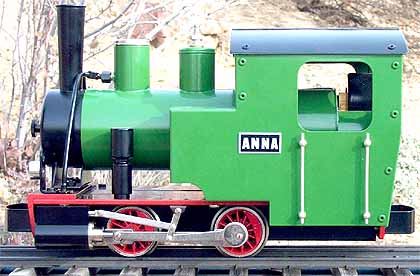
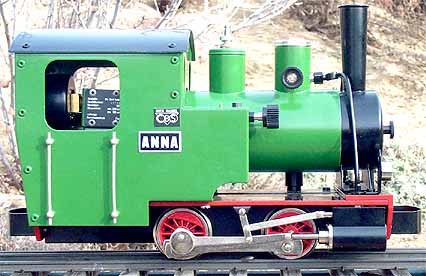
Anna looks more or less the same from either side. The left side sports the lumpish air pump.
.
The rudimentary controls are on the right side of the locomotive.
.
.
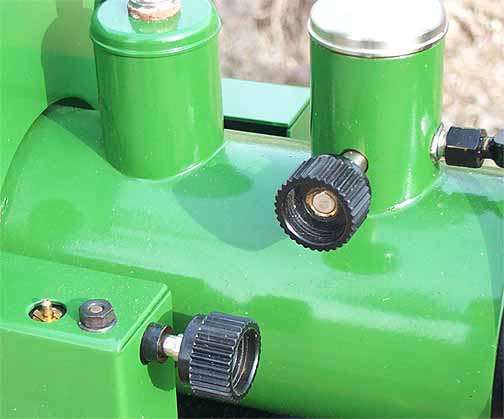

.




Right: The lubricator is a reservoir in the steam dome, just above the throttle. Most of the oil was immediately dumped into the cylinders, but the system was effective enough.
Far right: The engine's underside is plain in the extreme -- just the bare essentials.
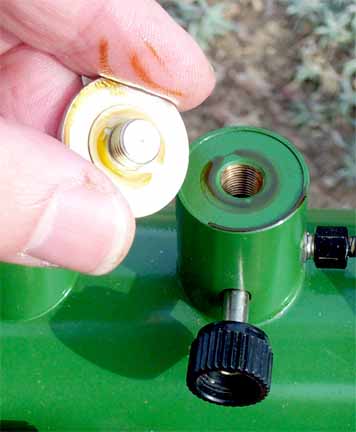
.
.
.
If you responded to a magazine ad in 1979, this flyer is what you would receive. It describes the engine in detail and depicts it in sparkling black-and-white.
.
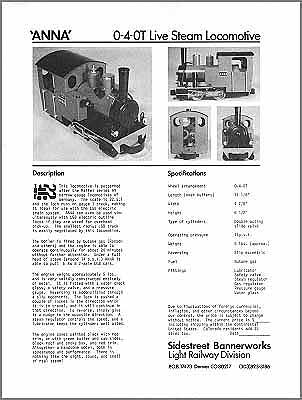
Back to Loco of the Month home page
Back to Sidestreet Bannerworks home page
This page and its contents
Copyright Sidestreet Bannerworks, 2004
.